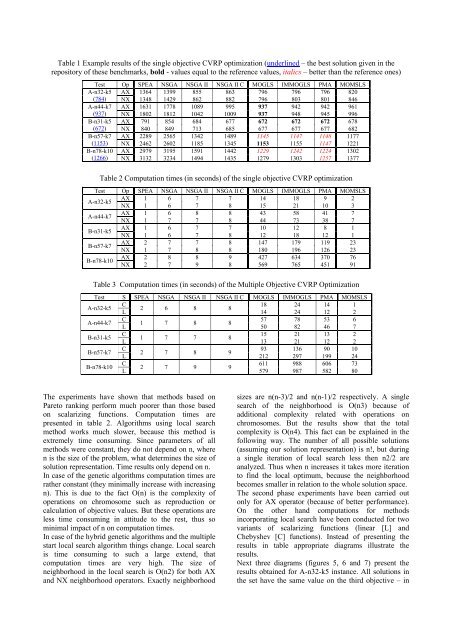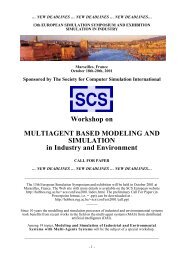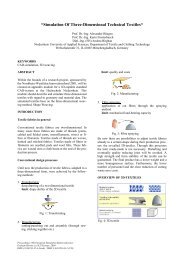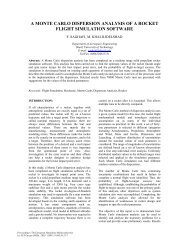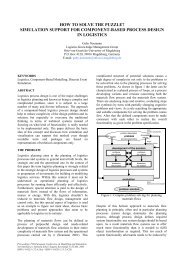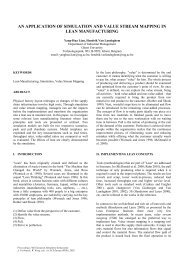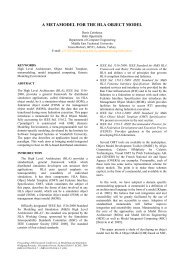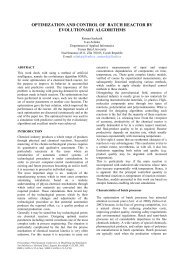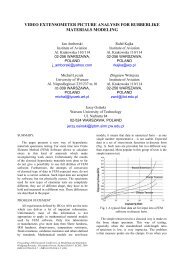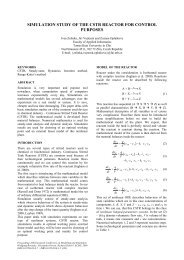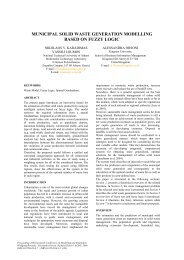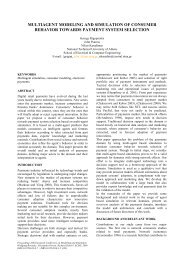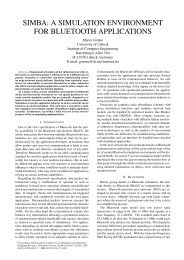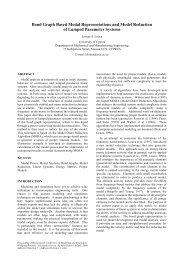decision support system in city logistics - The Society for Modelling ...
decision support system in city logistics - The Society for Modelling ...
decision support system in city logistics - The Society for Modelling ...
Create successful ePaper yourself
Turn your PDF publications into a flip-book with our unique Google optimized e-Paper software.
Table 1 Example results of the s<strong>in</strong>gle objective CVRP optimization (underl<strong>in</strong>ed – the best solution given <strong>in</strong> the<br />
repository of these benchmarks, bold - values equal to the reference values, italics – better than the reference ones)<br />
Test Op SPEA NSGA NSGA II NSGA II C MOGLS IMMOGLS PMA MOMSLS<br />
A-n32-k5 AX 1364 1399 855 863 796 796 796 820<br />
(784) NX 1348 1429 862 882 796 803 801 846<br />
A-n44-k7 AX 1631 1778 1089 995 937 942 942 961<br />
(937) NX 1802 1812 1042 1009 937 948 945 996<br />
B-n31-k5 AX 791 854 684 677 672 672 672 678<br />
(672) NX 840 849 713 685 677 677 677 682<br />
B-n57-k7 AX 2289 2565 1342 1489 1145 1147 1148 1177<br />
(1153) NX 2462 2602 1185 1345 1153 1155 1147 1221<br />
B-n78-k10 AX 2979 3195 1591 1442 1229 1242 1224 1302<br />
(1266) NX 3132 3234 1494 1435 1279 1303 1257 1377<br />
Table 2 Computation times (<strong>in</strong> seconds) of the s<strong>in</strong>gle objective CVRP optimization<br />
Test Op SPEA NSGA NSGA II NSGA II C MOGLS IMMOGLS PMA MOMSLS<br />
A-n32-k5<br />
AX 1 6 7 7 14 18 9 2<br />
NX 1 6 7 8 15 21 10 3<br />
A-n44-k7<br />
AX 1 6 8 8 43 58 41 7<br />
NX 1 7 7 8 44 73 38 7<br />
B-n31-k5<br />
AX 1 6 7 7 10 12 8 1<br />
NX 1 6 7 8 12 18 12 1<br />
B-n57-k7<br />
AX 2 7 7 8 147 179 119 23<br />
NX 1 7 8 8 180 196 126 23<br />
B-n78-k10<br />
AX 2 8 8 9 427 634 370 76<br />
NX 2 7 9 8 569 765 451 91<br />
Table 3 Computation times (<strong>in</strong> seconds) of the Multiple Objective CVRP Optimization<br />
Test S SPEA NSGA NSGA II NSGA II C MOGLS IMMOGLS PMA MOMSLS<br />
A-n32-k5<br />
C 18 24 14 1<br />
2 6 8 8<br />
L<br />
14 24 12 2<br />
A-n44-k7<br />
C 57 78 53 6<br />
1 7 8 8<br />
L<br />
50 82 46 7<br />
B-n31-k5<br />
C 15 21 13 2<br />
1 7 7 8<br />
L<br />
13 21 12 2<br />
B-n57-k7<br />
C 93 136 90 10<br />
2 7 8 9<br />
L<br />
212 297 199 24<br />
B-n78-k10<br />
C 611 988 606 73<br />
2 7 9 9<br />
L<br />
579 987 582 80<br />
<strong>The</strong> experiments have shown that methods based on<br />
Pareto rank<strong>in</strong>g per<strong>for</strong>m much poorer than those based<br />
on scalariz<strong>in</strong>g functions. Computation times are<br />
presented <strong>in</strong> table 2. Algorithms us<strong>in</strong>g local search<br />
method works much slower, because this method is<br />
extremely time consum<strong>in</strong>g. S<strong>in</strong>ce parameters of all<br />
methods were constant, they do not depend on n, where<br />
n is the size of the problem, what determ<strong>in</strong>es the size of<br />
solution representation. Time results only depend on n.<br />
In case of the genetic algorithms computation times are<br />
rather constant (they m<strong>in</strong>imally <strong>in</strong>crease with <strong>in</strong>creas<strong>in</strong>g<br />
n). This is due to the fact O(n) is the complexity of<br />
operations on chromosome such as reproduction or<br />
calculation of objective values. But these operations are<br />
less time consum<strong>in</strong>g <strong>in</strong> attitude to the rest, thus so<br />
m<strong>in</strong>imal impact of n on computation times.<br />
In case of the hybrid genetic algorithms and the multiple<br />
start local search algorithm th<strong>in</strong>gs change. Local search<br />
is time consum<strong>in</strong>g to such a large extend, that<br />
computation times are very high. <strong>The</strong> size of<br />
neighborhood <strong>in</strong> the local search is O(n2) <strong>for</strong> both AX<br />
and NX neighborhood operators. Exactly neighborhood<br />
sizes are n(n-3)/2 and n(n-1)/2 respectively. A s<strong>in</strong>gle<br />
search of the neighborhood is O(n3) because of<br />
additional complexity related with operations on<br />
chromosomes. But the results show that the total<br />
complexity is O(n4). This fact can be expla<strong>in</strong>ed <strong>in</strong> the<br />
follow<strong>in</strong>g way. <strong>The</strong> number of all possible solutions<br />
(assum<strong>in</strong>g our solution representation) is n!, but dur<strong>in</strong>g<br />
a s<strong>in</strong>gle iteration of local search less then n2/2 are<br />
analyzed. Thus when n <strong>in</strong>creases it takes more iteration<br />
to f<strong>in</strong>d the local optimum, because the neighborhood<br />
becomes smaller <strong>in</strong> relation to the whole solution space.<br />
<strong>The</strong> second phase experiments have been carried out<br />
only <strong>for</strong> AX operator (because of better per<strong>for</strong>mance).<br />
On the other hand computations <strong>for</strong> methods<br />
<strong>in</strong>corporat<strong>in</strong>g local search have been conducted <strong>for</strong> two<br />
variants of scalariz<strong>in</strong>g functions (l<strong>in</strong>ear [L] and<br />
Chebyshev [C] functions). Instead of present<strong>in</strong>g the<br />
results <strong>in</strong> table appropriate diagrams illustrate the<br />
results.<br />
Next three diagrams (figures 5, 6 and 7) present the<br />
results obta<strong>in</strong>ed <strong>for</strong> A-n32-k5 <strong>in</strong>stance. All solutions <strong>in</strong><br />
the set have the same value on the third objective – <strong>in</strong>


